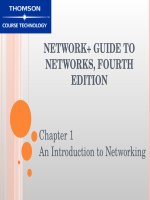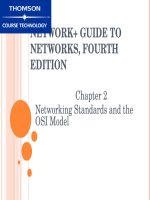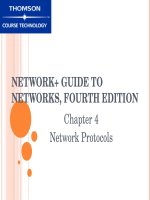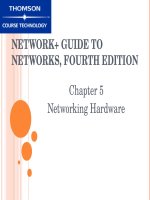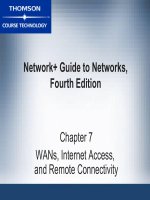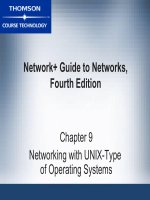NETWORK+ GUIDE TO NETWORKS, FOURTH EDITION - CHAPTER 11 ppt
Bạn đang xem bản rút gọn của tài liệu. Xem và tải ngay bản đầy đủ của tài liệu tại đây (1018.66 KB, 50 trang )
Network+ Guide to Networks,
Fourth Edition
Chapter 11
In-Depth TCP/IP Networking
Objectives
• Understand methods of network design unique to
TCP/IP networks, including subnetting, CIDR, NAT
and ICS
• Explain the differences between public and private
networks
• Describe protocols used between mail clients and
mail servers, including SMTP, POP3, and IMAP4
• Employ multiple TCP/IP utilities for network
discovery and troubleshooting
Network+ Guide to Networks, 4e
2
Designing TCP/IP-Based Networks
• Review of some TCP/IP fundamentals:
– IP is a routable protocol
– On a network using TCP/IP, each interface
associated with unique IP address
– Some nodes may use multiple IP addresses
– IP addresses consist of four 8-bit octets
– Many networks assign IP addresses and host names
dynamically, using DHCP
– Every IP address can be associated with a network
class
Network+ Guide to Networks, 4e
3
Subnetting
• Separates network into multiple, logically defined
segments (subnets)
• Each subnet’s traffic separated from every other
subnet’s traffic
– Enhances security
• Subnetworks must be connected via routers or other
Layer 3 devices
– Improves performance
• Data is selectively retransmitted
– Simplifies troubleshooting
Network+ Guide to Networks, 4e
4
Classful Addressing
• Adheres to network class distinctions
– Only Class A, B, and C addresses are recognized
– Network ID limited to first 8 bits in Class A, first
16 bits in Class B, and first 24 bits in Class C
• Fixed network ID size ultimately limits number of
hosts a network can include
Network+ Guide to Networks, 4e
5
Classful Addressing (continued)
Figure 11-1: Example IP addresses with classful addressing
Network+ Guide to Networks, 4e
6
Subnet Masks
• Subnetting depends on subnet masks to identify
how a network is subdivided
– Indicates where network information is located in an
IP address
– “1” bits indicate corresponding bits in IP address
contain network information
– “0” bits indicate corresponding bits in IP address
contain host information
• To calculate host’s network ID given IP address
and subnet mask, perform ANDing
Network+ Guide to Networks, 4e
7
Subnet Masks (continued)
Table 11-1: Default subnet masks
Network+ Guide to Networks, 4e
8
Subnet Masks (continued)
Table 11-2: ANDing
Figure 11-2: Example of calculating a host’s network ID
Network+ Guide to Networks, 4e
9
Reserved Addresses
• Certain types of IP addresses reserved for special
functions
– In network IDs, bits for host information set to 0
– In broadcast addresses, octet(s) representing host
information set to all 1s (255 in decimal notation)
Network+ Guide to Networks, 4e
10
Subnetting Techniques
• Subnetting breaks rules of classful addressing
– Some bits that in classful addressing would
represent host information changed to represent
network information
– Reduce number of usable host addresses per
subnet
Network+ Guide to Networks, 4e
11
Subnetting Techniques (continued)
Table 11-3: Class B subnet masks
Network+ Guide to Networks, 4e
12
Subnetting Techniques (continued)
Table 11-4: Class C subnet masks
Network+ Guide to Networks, 4e
13
Calculating Subnets
• Formula for determining how to modify a default
subnet mask: 2n-2=Y
– n = number of bits in subnet mask that must be
switched from 0 to 1
– Y = number of subnets that result
• Extended network prefix: Additional bits used for
subnet information plus existing network ID
• Class A, B, and C networks can all be subnetted
• External routers pay attention to only the network
portion of devices’ IP addresses
Network+ Guide to Networks, 4e
14
Calculating Subnets (continued)
Figure 11-3: A router connecting several subnets
Network+ Guide to Networks, 4e
15
Calculating Subnets (continued)
Figure 11-3 (continued): A router connecting several subnets
Network+ Guide to Networks, 4e
16
CIDR (Classless Interdomain Routing)
• Classless routing or supernetting
• Provides additional ways of arranging network and
host information in an IP address
• Supernet: Subnet created by moving subnet
boundary to the left
– Generates more usable IP addresses
• CIDR notation (slash notation): network ID followed
by forward slash (/), followed by number of bits
used for extended network prefix
– CIDR Block
Network+ Guide to Networks, 4e
17
CIDR (continued)
Figure 11-4: Subnet mask and supernet mask
Figure 11-5: Calculating a host’s network ID on a supernetted
network
Network+ Guide to Networks, 4e
18
Internet Gateways
• Combination of software and hardware enabling
two different network segments to exchange data
• Every device on a TCP/IP-based network has a
default gateway
–
–
–
–
First interprets outbound requests to other subnets
Interprets inbound requests from other subnets
Each node on network has one default gateway
May be network interface on a router
• Must maintain routing tables as well
• Core gateways make up the Internet backbone
Network+ Guide to Networks, 4e
19
Internet Gateways (continued)
Figure 11-6: The use of default gateways
Network+ Guide to Networks, 4e
20
NAT (Network Address Translation)
• Default gateways can be used to “hide” IP numbers
assigned within an organization
– Clients behind gateway may use any IP addressing
scheme
• Even non-legitimate schemes
– Must have legitimate IP address to exchange data
with Internet
• NAT: when client’s transmission reaches default
gateway, it assigns client’s transmission a valid IP
address
Network+ Guide to Networks, 4e
21
NAT (continued)
Figure 11-7: NAT through an Internet gateway
Network+ Guide to Networks, 4e
22
ICS (Internet Connection Sharing)
• Computer with Internet access (ICS host)
configured to translate requests to and from
Internet on behalf of other computers on network
– Acts as DHCP server, DNS resolver, and NAT
gateway for clients on its LAN
• Network adapter on ICS host assigned IP address
of 192.168.0.1
– Clients must be set up to obtain IP addresses
automatically
– ICS host assigns clients IP addresses in range of
192.168.0.2 through 192.168.0.255
Network+ Guide to Networks, 4e
23
Intranets and Extranets
• Intranet: network or part of network that uses
browser-based services to exchange information
within an enterprise
– Used for supplying HTTP-accessible documents,
e-mail, file sharing, document management, and
collaboration
– Defined by its security policies
• Extranet: network that uses Internet-like services
and protocols to exchange information within an
organization and with certain, authorized users
outside of that organization
Network+ Guide to Networks, 4e
24
TCP/IP Mail Services
• E-mail is most frequently used Internet service that
network administrators manage
• Mail servers communicate with other mail servers
to deliver messages across Internet
• Hundreds of software packages for mail servers
exist
– Sendmail, Microsoft Exchange Server, Lotus Notes,
Novell Groupwise
• Mail clients send/retrieve messages to/from mail
servers
• Servers and clients communicate through TCP/IP
Application layer protocols
Network+ Guide to Networks, 4e
25

